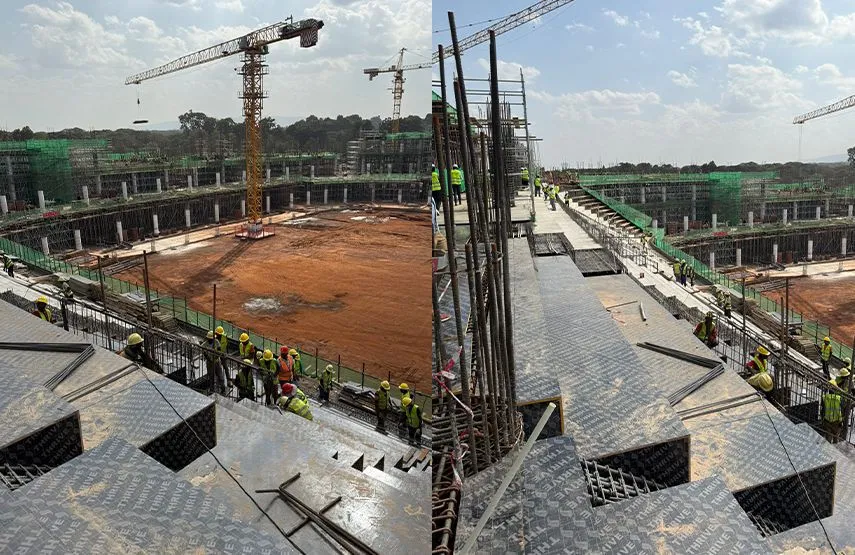As the world turns its gaze toward East Africa, Kenyan stadium developments are unfolding as much more than brick, steel, and turf. They have become lightning rods for hope, pride, scrutiny, and no shortage of controversy, especially as Kenya prepares to co-host both the 2024 African Nations Championship (CHAN) and the 2027 Africa Cup of Nations (AFCON). Behind official statements and budget lines, there are human stories: hungry athletes, restless fans, relentless contractors – and every citizen who has ever dared to dream of greatness inside a world-class arena.
Nyayo and Kasarani – historic venues face ticking clock
It’s impossible to overstate the symbolic weight carried by Nyayo National Stadium and Moi International Sports Centre, Kasarani. These are not just structures. They are cathedrals of Kenyan sport, engrained in the national psyche. Today, both stand at the center of an urgent upgrade effort. According to the latest government timelines, renovations are nearly 70 percent (Nyayo) and 79 percent (Kasarani) complete, with reopening scheduled for mid and late June 2025 respectively.
In the case of Nyayo, a fresh tartan track from renowned Spanish outfit Mondo is being installed in time for the prestigious Kip Keino Classic. Not only record-chasing athletes like Faith Kipyegon and Beatrice Chebet will find inspiration on the new surface, but a generation of hopefuls will see the stadium transformed – a symbol that Kenyan athletics remains firmly pointed toward the future.
Kasarani’s more extensive Ksh6.7 billion facelift is split between delivering a flawless CHAN in August 2025 and a full-scale, CAF-compliant facility for AFCON 2027. Ministry of Defence Cabinet Secretary Soipan Tuya has been blunt: CHAN’s delay to August (from its original February schedule) buys necessary time, but the pressure remains relentless. For the Harambee Stars and Kenyan fans, the clock ticks with every passing day.
Talanta Sports City – Kenya’s flagship stadium and its challenges
Nothing quite captures the ambition and tension of this moment like Talanta Sports City. Rising just off Ngong’ Road in Nairobi, the 60,000-seater stadium is not only billed as the main venue for the AFCON 2027 finale but is also a case study in politics, economics, and sheer determination.
The scale is breathtaking – Ksh44.7 billion earmarked, three shifts of workers (day and night, employing 3,500 people), and the eyes of the presidency watching every move. President William Ruto has stated, in no uncertain terms, that the December 2025 completion deadline is non-negotiable. Recent site visits have shown skeletal and canopy structures taking form, but not without drama: Parliamentary committees question budget allocations, contractors point to payment gaps, and local engineering teams race weather and logistical bottlenecks.
In a nod both to sustainability and fan experience, Talanta City is to be complemented by a major transport overhaul, including a planned modern rail system. The intention? Ensure 60,000 fans can access the heart of the action without bottlenecks, transforming live sport into a truly communal experience. Enhancements such as solar panel installations and FIFA-standard features hint at a new era for Kenyan venues – but they also raise the bar for accountability.
| CASINO | BONUS | INFO | RATING | |
|---|---|---|---|---|
|
bonus
New players get 50 free spins and a Ksh 2500 freebet!
See 7 Bonuses
|
info
BK 0000665 PG 0000405 Good combination of online casino and betting platform |
|||
|
bonus
Daily 25% bonus on your deposits!
See 6 Bonuses
|
info
Curacao 1668/JAZ Generous casino bonuses |
|||
|
bonus
Refer friends, win cash prizes!
|
info
BK 0000672 PG 0000412 Mobile-friendly |
|||
|
bonus
Register for up to 31,400 KSH bonus on deposits!
See 12 Bonuses
|
info
No. ALSI-112310012-F15 Unique selection of slots & games |
Kipchoge Keino and the perils of stalled progress
If Talanta City is a dream sprinting toward reality, then Kipchoge Keino Stadium in Eldoret is a cautionary tale. Once earmarked as a key support venue for both CHAN and AFCON, its progress has ground to a devastating halt. A fact-finding mission by the National Assembly Sports & Culture Committee found little on the ground to match official reports. The lead contractor blames funding bottlenecks, with only KSh300 million spent of a Ksh3.5 billion allocation. Political oversight escalated to calls for the Ethics and Anti-Corruption Commission to investigate, all while the hopes of local athletes hang in the balance.
This scenario is not just about timelines and budgets—it’s about the risk of lost dreams. “We will be doing a lot of disservice to them and Kenyans at large if we continue derailing completion,” warned committee chair Dan Wanyama. For anyone who has witnessed Kenyan distance runners train under spartan conditions, the stadium’s delayed completion is more than an infrastructure issue. It is a question of national justice.
Raila Odinga Stadium – community, legacy, and a model for modernisation
Meanwhile, in Homa Bay, the reborn Raila Odinga Stadium tells a more uplifting story. Expanded from just 3,000 to 12,000 seats through precast construction technology and a tight five-month timeline, it stands ready for the 2025 Madaraka Day celebration. Its journey encapsulates what government ambition, local leadership, and modern engineering can deliver when priorities are aligned. With future plans for a tartan running track and Bermuda grass pitch, the venue will continue to serve both elite competitors and the local community, amplifying the role of sport as a motor for regional development.
Broader impact – infrastructure, pride, and the future of Kenyan sport
The revitalisation of Kenyan stadiums is about more than matches and medals. It’s about nation-building on a very public stage. These projects have created thousands of jobs and brought attention to the need for world-class event management, accessible transport, and sustainable design. The inclusion of training sites like Ulinzi Sports Complex and Police Sacco Stadium shows that this is a deep, systemic investment in sport, not mere window-dressing.
The road ahead is not without twists: questions of fiscal management, race-against-time deadlines, and the need for transparency remain unresolved. Yet, the drive from athletes, fans, and leadership indicates that, for every setback, the dream remains stubbornly alive.
What matters most
As the August 2025 kickoff for CHAN draws near, followed by the bigger stage at AFCON 2027, Kenya’s stadium projects remain a living canvas. They are filled equally with setbacks and successes, heated debates and communal pride. Beyond the concrete and turf, the nation’s sporting spirit – forged in adversity and ambition – is being tested, reshaped, and, ultimately, given a new arena in which to dream. The hope is that, when the lights go up and the fans finally pour in, the stories written on these renovated and brand-new stages will be worthy of the generations that sacrificed, persevered, and never stopped believing in the power of sport to unite and uplift a nation.










